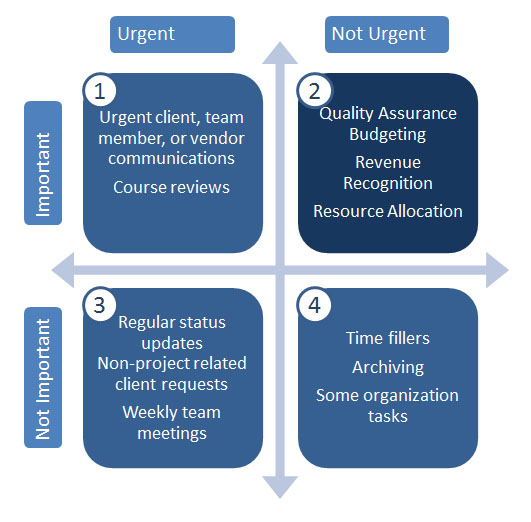 The red exclamation point—it turns up in the morning email routine like a bad penny. It stares at you unblinkingly, telling you that there is something lurking behind that subject line that you might not know yet, hinting that it will be there to disrupt your morning goals and suck your time into the oblivion of the email’s black hole.
The red exclamation point—it turns up in the morning email routine like a bad penny. It stares at you unblinkingly, telling you that there is something lurking behind that subject line that you might not know yet, hinting that it will be there to disrupt your morning goals and suck your time into the oblivion of the email’s black hole.
Or not.
The problem with that little mark, the “high importance” mark that is often an exclamation point or a star, is that it is more often used for emails that are urgent, rather than emails that are important. Long before the invention of email, Eisenhower said, “What is important is seldom urgent and what is urgent is seldom important,” and that could apply to many emails to grace my inbox. It might be nice if there were a different mark for urgent issues, but the lack of an “urgent” marker points to a larger problem in the general population: It’s harder than we think to distinguish the urgent from the important.
Unfortunately, that distinction lies at the heart of good time management, and consequently, good project management.
Covey and Lakein’s Urgent-Important Matrix (1989) is a helpful tool for time management. It has certainly helped me be a better project manager developing training. Below I have organized and categorized tasks that project managers of training projects regularly face in the workplace into this Urgent-Important Matrix.
This matrix is a helpful tool to organize and prioritize project management tasks, and the critical thing to remember that in a fast-paced work environment, the urgent tasks will beckon us to spend all of our time there. Some urgent things do merit our immediate time, such as those in Quadrant 1, but other urgent matters are less important and go in Quadrant 3. Meanwhile, other important tasks don’t come with an urgency stamp, such as those in Quadrant 2, and those are tasks we tend to procrastinate but regret later. So while a pressing need from a client or a call from my translation vendor may be something that merits my immediate attention, I must also recognize that important but routine tasks in Quadrant 2 such as quality assurance on my developing training projects, budgeting and billing, and working toward overall team goals need my time and attention as well. Regrets happen down the road when Quadrant 3 tasks are regularly prioritized over Quadrant 2 tasks, letting urgency overtake what is more important.
In order to be sure I make time for non-urgent important tasks, I find it’s best to actually dedicate time to tasks for Quadrant 2. I set aside about two hours each afternoon to check in with my team members and make sure that they know their assignments or that they have checked with their reports. I hold regular one-on-one meetings with the instructional designers on my team to review the quality of the courses created, and I reserve time to work on development assignments I receive from the Director of Project Management that strengthen my skills as a project manager. I hold regular reviews of revenue recognized on my projects and review client invoices and collection in relation to planned project deliverables. All of these tasks are the heart of what makes an instructional design business run, and they are well deserving of my planning and time.
In addition to using the matrix to prioritize my own tasks, the matrix can be an important tool for assessing if you and others are in alignment with the priority of a shared task, for instance, communicating priorities to team members, or for making sure that external team members such as clients and vendors are aligned with the information they need to prioritize their project tasks effectively to meet the project’s goals.
Here are some actions a project manager can take with external and internal team members to ensure that time is spent on the highest priority activities when developing a training project:
1. Agree on project goals
2. Verify the importance of timeline on a given project
3. Establish regular task and project status meetings
4. Communicate predecessors to important tasks
5. Use tools to effectively assign tasks and follow-up
Each one of these could be its own blog post, so I will have to tease you with the short list for now. And once you sort the urgent and the important, the most important actions you can take all involve communication with others to reassess your priorities and encourage them to realign theirs. A little planning and regular communication can spare your inbox from a lot of urgent emails masquerading as the important tasks of your day.
Subscribe
Related Articles
Learner Experience Evolution
For learning leaders driving change in onboarding, leadership development, sales [...]
The Power Of Learner-Centered Compliance Training: Engaging Learners, Reducing Risk
This article was written and originally posted by Brandon Hall [...]
Finding the Right Training Company
Part 2: Creating Your Shortlist Finding the right training company [...]
